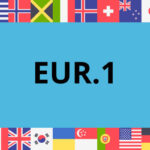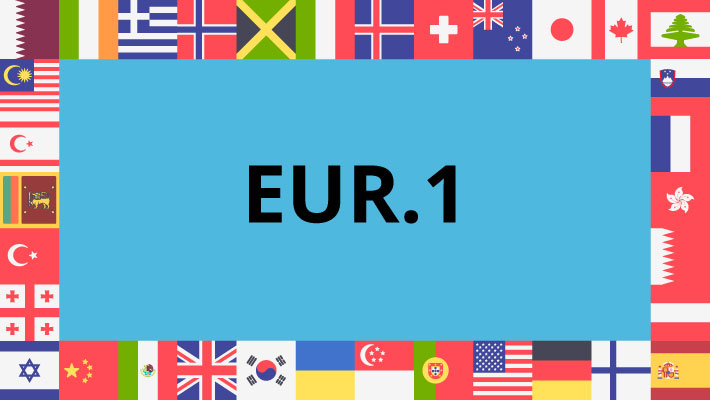
In Oil Exploration Drilling and Shore Work
19 Ocak 2025
EUR.1
19 Ocak 2025What is the Concept of Origin of Goods?
Although there is no internationally agreed-upon definition, “origin” can be defined as “the economic nationality of a good.”
Goods that are wholly obtained or produced in a country, including its territorial waters, are considered to originate from that country. However, if the goods undergo processing or transformation in another country or if the production process takes place in multiple countries, the goods may acquire a different origin. The origin of goods, non-preferential origin, and preferential origin are regulated in Articles 17 to 21 of the Customs Law No. 44458 and in the relevant regulations.
Countries such as Iran, Iraq, Yemen, UAE, Lebanon, Kuwait, Saudi Arabia, Serbia, Montenegro, India, South Africa, TRNC, China, Algeria, Libya, Mexico, Malaysia, etc., and all countries worldwide except EU member states, EFTA countries, and countries with which a Free Trade Agreement (FTA) has been signed.
This document is used to prove;
- In which country the traded goods were produced.
- If the goods undergo complementary processing in another country in raw or semi-finished form, the country where the complementary processing took place.
- Consult a customs consultant for necessary situations based on the Harmonized Customs Tariff principles, depending on the nature of the traded goods.
Countries want to know the origin of imported products when trading with each other. This is because, in import procedures, products must be treated according to their origin.
Situations Where Products Are Treated According to Their Origin
The country of origin of a product directly affects the following aspects in customs procedures:
- Calculation of customs duties
- Monitoring the application of tools such as quotas and anti-dumping measures to control foreign trade
Information Required in a Certificate of Origin
Certificates of Origin must include the following information:
- Name, surname, and address of the sender
- Name, surname, and address of the recipient
- Marks, numbers, types, and quantities of containers
- Type and nature of the goods, net and gross weights, value, and mode of transport
- Certification of the issuing authority (date, signature, seal, and stamp),
- If the Certificate of Origin is issued based on the processing or transformation of the goods in that country, this must be explained in detail.
How to Fill Out the Document;
- Exporter’s name and address information
- Buyer’s name and address information,
- Information regarding the mode of transport (sea, air, land)
- Marks and numbers of packages
- Gross weight
- Invoice number, if requested, and other information
- Customs approval area: The section where the exporter or their representative records the date and applies their stamp and signature
FORM A – Special Certificate of Origin
This is a type of certificate of origin required for industrial goods imported from developing countries by certain countries (especially industrialized countries) to support the industrialization of these countries. It is issued within the framework of the Generalized System of Preferences (GSP), which allows for preferential customs rates. Countries that provide such preferences to developing countries include: USA, Japan, New Zealand, Norway, Switzerland, Canada, Australia, Russia, Poland, Czech and Slovak Republics, Russia, Ukraine, Moldova, Japan, Canada, USA, Kazakhstan, Azerbaijan, Kyrgyzstan, Georgia, Tajikistan, Uzbekistan, New Zealand.
According to the Free Trade Agreement signed between Turkey and the countries listed above, this document is prepared and approved. Special Certificates of Origin required for products exported from Turkey are prepared by companies and approved by chambers of commerce and provincial units of the Undersecretariat of Foreign Trade.
Special Certificates of Origin can also be issued after the shipment of goods. If an approved Special Certificate of Origin is lost or destroyed, a new document can be issued and approved.
How to fill out the document:
- Exporter’s name and address information
- Buyer’s name and address information
- Information regarding the mode of transport (sea, air, land)
Box B: Country of departure - Blank
- Serial number
- Marks and numbers of packages
- Description of goods consistent with the invoice and packing list.
- Country/countries of origin
- Gross weight
- Invoice number, if requested
- Customs approval area
- The section where the exporter or their representative records the date and applies their stamp and signature.
ABC Form
This is a type of certificate of origin approved only by chambers of commerce and used for the export of all kinds of products to various countries. This document consists of three copies: A, B, and C. Copy C remains with the Chamber.
When Chamber members apply to the Chamber for the approval of the (ABC) Form, if the goods in question are produced by themselves, they must submit a capacity report or other documents proving that they are the producer of the goods, along with a copy of the sales invoice. The form must be filled out properly, and the right side of the 8th column must be stamped and signed by the company.
If the goods in question are not produced by the exporting company, the sales invoice, procurement invoices, and the producer’s capacity report are required. If the producer does not have a capacity report, other documents proving that the producer manufactures the goods in question are sufficient.






